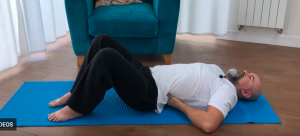How stressed are you? That’s a good question to ask yourself regulary, particularly during these challenging times. Stress is definitely something you want to learn how to recognise in yourself, so that you can regulate, and manage, your responses to it.
If you are a regular reader of this blog you will no doubt be familiar with the fact that stress causes our muscles to tense. Or rather that our brain instructs our muscles to tense in response to stressful event or situations. These muscular contractions are involuntary/reflexive, they happen automatically, often we are not even aware of them occuring. Like for example; the slow accumulation of stress and tension as a work deadline looms, or as a lockdown is extended indefinitely.
Other times it is more blatantly obvious, for example if you have a near miss when driving, or get some kind of a fright.
Interestingly, even just thinking about stressful events or situations can trigger this response too. Such as say, ruminating over an argument, a perceived wrong or a nerve-racking interview.
If we know muscle tension is an automatic response to stress, we can use muscle tension as a good indicator of how stressed we are. And conversely we can use an absence of muscle tension as a good indicator of how relaxed we are.
So How Can We Assess Muscle Tension?
It’s really very easy to assess yourself for muscle tension. All you need is your own hands. Tense, tight, contracted muscles feel stiff and hard, they will often be tender and sore to touch too. They make your movements feel stiff and restricted. Knots in your muscles are also merely contracted muscle fibres, small sections of the muscle that are habitually contracted.
Relaxed muscles on the other hand are soft, pliable and pain free. They will not be sore to the touch and they allow for free and easy movement. Fully relaxed muscles also will not have knots of tension in them.
So armed with this simple information we can easily start to identify which parts of our body are the most tense, and where we tend to express our stress, by simple pressing on our muscles.
Let’s Find our Tight, Tense, Stressed Out Spots!
Whilst sitting (or standing) it’s very easy to take your right hand and press the muscles on the top of and to the rear of your left shoulder. Just like in the image below. In fact I’m sure many of you do this kind of thing instinctively already. When you do this, let your left arm hang loosely by your side.

Press gently on the top of the left shoulder moving your hand more inwards towards the neck and then more out towards the outermost part of your shoulder. You’ll likely find that parts of the shoulder are very hard, tight and uncomfortable to press on. That’s muscle tension! Make a note of these areas or spots.
Then, switch sides. Let your right arm hang loosely, then use your left hand to press on the muscles of your right shoulder in the same way described above. Again notice which areas are stiff, tight, hard and tender to touch. There may be some difference side to side. Just make a note.
All those areas that are hard, tight, and tender to touch on your shoulder are areas where the muscles are habitually contracted. Your brain is holding those muscles more tightly than is necessary. This is Sensory Motor Amnesia in action. You have forgotten how to let these muscles relax.
Now allowing your right arm to hang loosely by your side, take your left hand again and press on your right chest muscle, from your sternum (the hard area in centre of your chest) all the way out to your ampit, and also all the way along under your collarbone fron the centre out. Again your looking for areas that are hard, tight, tender and sore. If you find tender spots, make a note of them.
Then repeat this process on the other side, using your right hand to press on your left chest as you let your left arm hang loosely by your side.
You can do this all over your body, pressing gently and noticing where is hard and tight, and where is soft and relaxed.
You might be surprised at just how much of your body is stiff, hard, and tight. No wonder you feel stressed right?
To asess the tension in your lower back, it’s probably best to lay down on your back and bend your legs with feet flat on the floor. Then take your hands and feel the muscles either side of your spine down low on your back, as shown below. Again it will become evident very quickly if these areas are tense when we begin to press on them. They’ll be hard, knotted and tender. They may even feel warmer than more relaxed areas.

Press gently on your neck, on the front, at the base of your skull in the back, and a little on the sides too. If your neck muscles are tight and hard, you are inevitably going to have a stiff neck and restricted movement of the head AND the shoulders. You may even find pressing on tight spots at the base of your skull actually recreates the feeling of a headache? (Hmmm… so that’s where the phrase tension headache comes from!)
In this position you can also press on your belly muscles, are they rock hard, held in contraction? Or soft and relaxed? When you breath in, does your belly expand freely? Or does the air go only into your chest? Again just take a note.
Press on your waist too, on your sides between your ribs and you hips, are they tight, tender, hard to touch? Is one side tighter or firmer than the other.
Get inquisitive about yourself!
Ask yourself, what’s going on here? Where am I holding muscular tension? Using the list below as a quick guide, assess where you are the most stiff, tight and tender.
Side Laying: Neck, Low back, Waist, Hips, Buttocks
Laying on your back: Neck, Chest, Belly, Waist, Hips, Thighs
Laying on your front: Lower back, Hips/Buttocks
Once you have made a note of all the are the areas that tight and stiff, you can then choose the most useful Somatic Movements to help you relax ALL THOSE TIGHT AREAS you found.
If you were mostly tight in the lower back, back of neck, back of shoulders, buttocks, and back of the body generally, this is indicative of Green Light Reflex. In this case why not sign up for my FREE BACK PAIN RELIEF VIDEO below. In the video I’ll guide you through the four most important Somatic Movements for releasing tension in the back of the body. Win win!
Or perhaps consider signing up for my
Back Pain Relief Online Workshop on April 3rd:
However, if you were mostly tight in the chest, belly, groin, front of shoulders, front of hips and front of the body generally, this is indicative of Red Light Reflex/Startle Reflex. In this case you will certainly benefit from the movement below:
And if you were mostly stiff, tight and sore in one side of your body generally, I suggest practicing the Side Bend, use the video below:
And lastly if you find you are stiff and sore all over, you should work through ALL the movements provided above.
After you have practiced these movements, re-test all the areas that felt tight, tender and sore to press on. If you have practiced the movements slowly and carefully, your muscles should now be feeling much softer and less tender to touch. You will have discovered that Somatic Movements can reduce muscle tension, fast!
You may also notice that after releasing muscle tension you feel more calm, relaxed and less stressed. Who knew! And best of all, you can recreate that feeling anytime when you Learn Somatics.
You can be fully in control of how stressed or relaxed you feel. And who wouldn’t want that?
If you’re interested in learning more about Somatic Movements you can book on Online 1-1 with me. Just click the button below.
And if you know someone who you think might benefit from this post please share it. You can do so using the share buttons at the bottom of this post. After all we could all do with less tension and stress and more calm in these challenging times.
As always thanks for reading!
Photo by Gift Habeshaw on Unsplash
